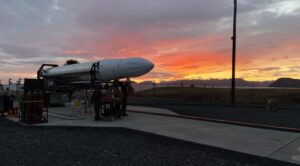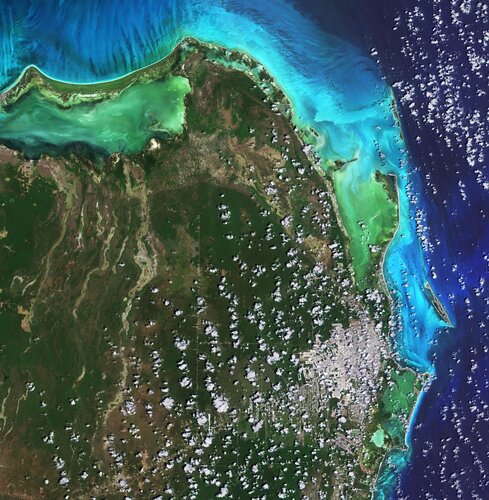Throwing a Cosmic Kiss – Matthias Maurer's journey to the International Space Station
Friday, 12 November 2021 15:30 Video:
00:02:42
Video:
00:02:42
ESA astronaut Matthias Maurer and NASA astronauts Raja Chari, Tom Marshburn and Kayla Barron liftoff to the International Space Station in the SpaceX Crew Dragon spacecraft “Endurance”.
Collectively known as “Crew-3”, the astronauts were launched from launchpad 39A at NASA's Kennedy Space Center in Florida, USA at 02:03 GMT/03:03 CET Thursday 11 November.
The spacecraft docked to the International Space Station at 00:32 CET Friday, 12 November/23:32 GMT Thursday, 11 November, marking the official start of Matthias's first mission.
Crew-3 will spend around six months living and working aboard the orbital outpost before returning to Earth. It is the first space mission for Matthias, who’s become the
Here we GO, Matthias
Friday, 12 November 2021 14:25 Image:
Image:
After a series of delays due to weather and a minor crew medical issue, ESA astronaut Matthias Maurer was finally launched to the International Space Station on 11 November. But not before reading some final words of support, shared by ESA astronaut Luca Parmitano, as Matthias waited to drive to the launchpad.
Alongside NASA astronauts Raja Chari, Tom Marshburn and Kayla Barron, Matthias lifted off on board Space X Crew Dragon “Endurance” at 03:03 CET Thursday 11 November and arrived ahead of schedule to the Station in the early hours of 12 November.
It is the first space
U.S. government contracts lift BlackSky’s financial performance
Friday, 12 November 2021 14:12
U.S. government contracts are boosting the financial performance of Earth observation company BlackSky, executives said Nov. 12 during the company’s first earnings call since going public.
South Korean ground station operator orders its first EO satellite
Friday, 12 November 2021 14:01
Contec signed a contract with NanoAvionics for an Earth observation satellite that will launch aboard a SpaceX Falcon 9 rocket in the second half of 2023.
The cosmos beckons for Snoopy onscreen and in real life
Friday, 12 November 2021 13:55
A new rocket designed to launch humans to the moon, Mars and beyond will launch next year from Kennedy Space Center in Florida. On board, will be a familiar fuzzy figure—Snoopy.
A 5-ounce plush toy version of the daydreaming beagle—wearing a space suit designed according to NASA's strict specifications—has an important job for the Artemis I unmanned mission.
NASA uses stuffed animals on flights because when the little guys start to float, it indicates that the spacecraft has entered space's zero gravity. Since the toys are soft and light, they won't break anything or accidentally strike a button.
The Artemis I mission is scheduled to circle the moon and then return to Earth in February as a dry run without astronauts, making sure all systems are working for future crewed missions. Also aboard will be two Lego figurines, part of an educational series.
A new era of planetary exploration: What we discovered on the far side of the moon
Friday, 12 November 2021 13:20
Seven months after it was launched, the US robotic rover Perseverance successfully landed on Mars on February 18 2021. The landing was part of the mission Mars2020 and was viewed live by millions of people worldwide, reflecting the renewed global interest in space exploration. It was soon followed by China's Tianwen-1, an interplanetary Mars mission consisting of an orbiter, lander and rover called Zhourong.
Perseverance and Zhourong were the fifth and sixth planetary rovers deployed in the last decade. The first one was America's Curiosity which landed on Mars in 2012, followed by China's three Chang'E missions.
In 2019 the Chang'E-4 lander and its Yutu-2 rover were the first human objects landed on the far side of the moon—the side that faces away from the Earth. This marked a pivotal milestone in planetary exploration, of equal importance to the Apollo 8 mission in 1968, when the far side of the moon was seen by humans for the first time.
To analyze the data captured from the Yutu-2 rover, which used ground-penetrating radar (GPR), we developed a tool that could detect in much greater detail the layers beneath the moon's surface than had ever been done before.
A chunk of Chinese satellite almost hit the International Space Station: The space junk problem is getting worse
Friday, 12 November 2021 13:10
Earlier this week, the International Space Station (ISS) was forced to maneouvre out of the way of a potential collision with space junk. With a crew of astronauts and cosmonauts on board, this required an urgent change of orbit on November 11.
Over the station's 23-year orbital lifetime, there have been about 30 close encounters with orbital debris requiring evasive action. Three of these near-misses occurred in 2020. In May this year there was a hit: a tiny piece of space junk punched a 5mm hole in the ISS's Canadian-built robot arm.
This week's incident involved a piece of debris from the defunct Fengyun-1C weather satellite, destroyed in 2007 by a Chinese anti-satellite missile test. The satellite exploded into more than 3,500 pieces of debris, most of which are still orbiting. Many have now fallen into the ISS's orbital region.
To avoid the collision, a Russian Progress supply spacecraft docked to the station fired its rockets for just over six minutes. This changed the ISS's speed by 0.7 meters per second and raised its orbit, already more than 400km high, by about 1.2km.
Week in images: 08 - 12 November 2021
Friday, 12 November 2021 13:09
Week in images: 08 - 12 November 2021
Discover our week through the lens
Nanoracks hires new CEO
Friday, 12 November 2021 11:54
Commercial space station company Nanoracks has hired a new chief executive as its co-founder and longtime head moves to a new position as its parent company.
Cosmic Kiss mission begins as Matthias Maurer arrives at the Space Station
Friday, 12 November 2021 10:33
The spacecraft carrying ESA astronaut Matthias Maurer and his NASA astronaut colleagues Raja Chari, Thomas Marshburn and Kayla Barron docked to the International Space Station at 00:32 CET Friday, 12 November (23:32 GMT Thursday, 11 November), marking the official start of Matthias’s first mission ‘Cosmic Kiss’.
Astra says focus is on launch as it files application for satellite constellation
Friday, 12 November 2021 10:32
A week after a filing an application with the FCC for a constellation of more than 13,000 satellites, Astra Space executives said that their near-term focus remains on developing their launch capabilities.
News conference with ESA astronaut Thomas Pesquet
Friday, 12 November 2021 10:00 Video:
00:55:31
Video:
00:55:31
Replay of the news conference with ESA astronaut Thomas Pesquet held at the European Astronaut Centre on 12 November.
Thomas splashed down on Earth after 199 days in space on 8 November. After being helped out of the Crew Dragon Endeavour, just four days later and after a boat, helicopter and multiple aircraft rides, Thomas arrived at the European Astronaut Centre in Cologne, Germany.
A one-hour news conference was held at ESA’s astronaut centre on 12 November.
Programme:
• Welcome by ESA’s Director of Human and Robotic Exploration Dave Parker.
• Statement from ESA’s Director General Josef Aschbacher
• Presentation on ESA’s vision
Earth from Space: Cancún, Mexico
Friday, 12 November 2021 08:00
Cancún, situated in Quintana Roo on the northeast coast of Mexico’s Yucatán Peninsula, is featured in this image captured by the Copernicus Sentinel-2 mission.
The Moon's top layer alone has enough oxygen to sustain 8 billion people for 100,000 years
Friday, 12 November 2021 07:38 Alongside advances in space exploration, we've recently seen much time and money invested into technologies that could allow effective space resource utilisation. And at the forefront of these efforts has been a laser-sharp focus on finding the best way to produce oxygen on the Moon.
In October, the Australian Space Agency and NASA signed a deal to send an Australian-made rover to the Moon
Alongside advances in space exploration, we've recently seen much time and money invested into technologies that could allow effective space resource utilisation. And at the forefront of these efforts has been a laser-sharp focus on finding the best way to produce oxygen on the Moon.
In October, the Australian Space Agency and NASA signed a deal to send an Australian-made rover to the Moon Russia successfully tests 'space radiation shield'
Friday, 12 November 2021 07:38 Space radiation may ride roughshod over a satellite's electrical circuits and result in a full-fledged burnout of its onboard systems. This remains one of the main headaches for satellite manufacturers.
Specialists from the Russian Space Systems holding (RSS) have successfully tested a miniature device designed to protect the electronic onboard systems of state-of-the-art satellites from c
Space radiation may ride roughshod over a satellite's electrical circuits and result in a full-fledged burnout of its onboard systems. This remains one of the main headaches for satellite manufacturers.
Specialists from the Russian Space Systems holding (RSS) have successfully tested a miniature device designed to protect the electronic onboard systems of state-of-the-art satellites from c 
